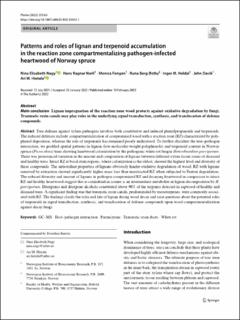| dc.contributor.author | Nagy, Nina Elisabeth | |
| dc.contributor.author | Norli, Hans Ragnar | |
| dc.contributor.author | Fongen, Monica | |
| dc.contributor.author | Østby, Runa Berg | |
| dc.contributor.author | Heldal, Inger | |
| dc.contributor.author | Davik, Jahn | |
| dc.contributor.author | Hietala, Ari Mikko | |
| dc.date.accessioned | 2022-10-12T08:15:19Z | |
| dc.date.available | 2022-10-12T08:15:19Z | |
| dc.date.created | 2022-05-10T14:09:21Z | |
| dc.date.issued | 2022-02-10 | |
| dc.identifier.citation | Planta. 2022, 255 (3), . | en_US |
| dc.identifier.issn | 0032-0935 | |
| dc.identifier.uri | https://hdl.handle.net/11250/3025494 | |
| dc.description.abstract | Tree defense against xylem pathogens involves both constitutive and induced phenylpropanoids and terpenoids. The induced defenses include compartmentalization of compromised wood with a reaction zone (RZ) characterized by polyphenol deposition, whereas the role of terpenoids has remained poorly understood. To further elucidate the tree–pathogen interaction, we profiled spatial patterns in lignan (low-molecular-weight polyphenols) and terpenoid content in Norway spruce (Picea abies) trees showing heartwood colonization by the pathogenic white-rot fungus Heterobasidion parviporum. There was pronounced variation in the amount and composition of lignans between different xylem tissue zones of diseased and healthy trees. Intact RZ at basal stem regions, where colonization is the oldest, showed the highest level and diversity of these compounds. The antioxidant properties of lignans obviously hinder oxidative degradation of wood: RZ with lignans removed by extraction showed significantly higher mass loss than unextracted RZ when subjected to Fenton degradation. The reduced diversity and amount of lignans in pathogen-compromised RZ and decaying heartwood in comparison to intact RZ and healthy heartwood suggest that α-conindendrin isomer is an intermediate metabolite in lignan decomposition by H. parviporum. Diterpenes and diterpene alcohols constituted above 90% of the terpenes detected in sapwood of healthy and diseased trees. A significant finding was that traumatic resin canals, predominated by monoterpenes, were commonly associated with RZ. The findings clarify the roles and fate of lignan during wood decay and raise questions about the potential roles of terpenoids in signal transduction, synthesis, and translocation of defense compounds upon wood compartmentalization against decay fungi. | en_US |
| dc.language.iso | eng | en_US |
| dc.publisher | Springer Nature | en_US |
| dc.rights | Navngivelse 4.0 Internasjonal | * |
| dc.rights.uri | http://creativecommons.org/licenses/by/4.0/deed.no | * |
| dc.title | Patterns and roles of lignan and terpenoid accumulation in the reaction zone compartmentalizing pathogen-infected heartwood of Norway spruce | en_US |
| dc.title.alternative | Patterns and roles of lignan and terpenoid accumulation in the reaction zone compartmentalizing pathogen-infected heartwood of Norway spruce | en_US |
| dc.type | Peer reviewed | en_US |
| dc.type | Journal article | en_US |
| dc.description.version | publishedVersion | en_US |
| dc.rights.holder | © The Author(s) 2022 | en_US |
| dc.source.pagenumber | 16 | en_US |
| dc.source.volume | 255 | en_US |
| dc.source.journal | Planta | en_US |
| dc.source.issue | 3 | en_US |
| dc.identifier.doi | 10.1007/s00425-022-03842-1 | |
| dc.identifier.cristin | 2023156 | |
| dc.relation.project | Norges forskningsråd: 281140 | en_US |
| dc.source.articlenumber | 63 | en_US |
| cristin.ispublished | true | |
| cristin.fulltext | original | |
| cristin.qualitycode | 1 | |

